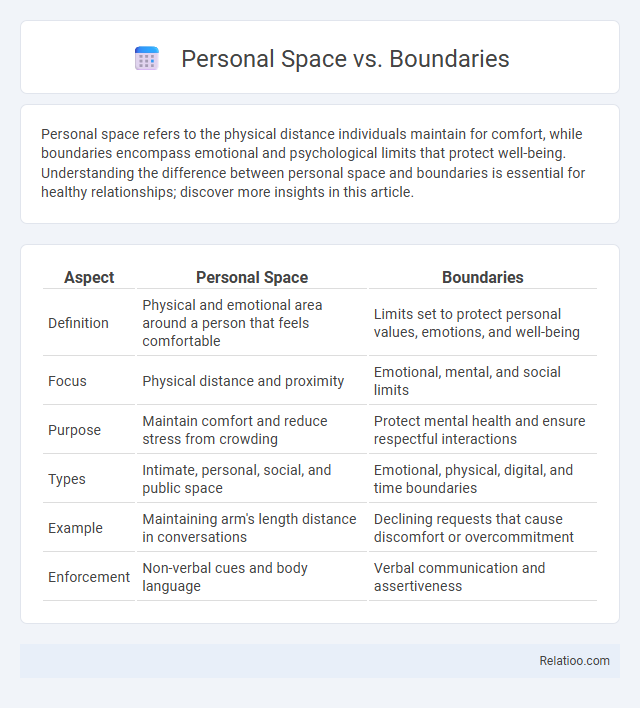Personal space refers to the physical distance individuals maintain for comfort, while boundaries encompass emotional and psychological limits that protect well-being. Understanding the difference between personal space and boundaries is essential for healthy relationships; discover more insights in this article.
Table of Comparison
| Aspect | Personal Space | Boundaries |
|---|---|---|
| Definition | Physical and emotional area around a person that feels comfortable | Limits set to protect personal values, emotions, and well-being |
| Focus | Physical distance and proximity | Emotional, mental, and social limits |
| Purpose | Maintain comfort and reduce stress from crowding | Protect mental health and ensure respectful interactions |
| Types | Intimate, personal, social, and public space | Emotional, physical, digital, and time boundaries |
| Example | Maintaining arm's length distance in conversations | Declining requests that cause discomfort or overcommitment |
| Enforcement | Non-verbal cues and body language | Verbal communication and assertiveness |
Understanding Personal Space: Definition and Importance
Understanding personal space involves recognizing the physical and emotional distance individuals need to feel safe and comfortable, critical for maintaining healthy interactions. Your ability to respect personal space fosters trust and reduces boundary conflicts, which can prevent misunderstandings and emotional discomfort. Clear awareness of personal space boundaries promotes stronger relationships by allowing others to feel valued and secure in social environments.
What Are Boundaries? Types and Functions
Boundaries are the limits and rules you set to protect your personal space, emotions, and well-being, serving as essential guides for healthy relationships. Types include physical boundaries, which define your comfort zone in terms of personal space; emotional boundaries, protecting your feelings and thoughts; and intellectual boundaries, respecting your ideas and beliefs. These boundaries function to maintain respect, prevent misunderstandings, and build trust, ensuring your needs are acknowledged and honored.
Key Differences Between Personal Space and Boundaries
Personal space refers to the physical distance individuals maintain to feel comfortable and secure, while boundaries encompass emotional, mental, and physical limits set to protect one's well-being. Unlike personal space, boundaries involve intentional rules or guidelines about how others can interact with someone's emotions, time, and energy. Trust issues complicate both concepts by making it harder to respect personal space and enforce boundaries, often leading to misunderstandings and emotional discomfort.
Cultural Influences on Personal Space and Boundaries
Cultural influences significantly shape perceptions of personal space and boundaries, affecting how individuals interact in social and professional settings. In collectivist cultures like Japan and China, closer physical proximity and less rigid boundaries are common, while in individualistic societies such as the United States and Germany, greater personal space and clear boundaries are emphasized to build trust. Misunderstandings around these cultural norms can lead to trust issues and discomfort, highlighting the importance of cultural awareness in cross-cultural communication.
How Personal Space Affects Interpersonal Relationships
Personal space plays a crucial role in shaping interpersonal relationships by influencing comfort levels and communication effectiveness. Respecting personal space fosters trust and reduces tension, while violations can lead to discomfort and conflict. Understanding individual boundaries within personal space is essential for nurturing healthy and respectful connections.
Setting Healthy Boundaries for Emotional Well-being
Setting healthy boundaries is essential for protecting your emotional well-being and maintaining personal space. Clear boundaries help differentiate your needs from others' expectations, fostering trust while preventing feelings of resentment or emotional depletion. Prioritizing these limits empowers you to build healthier relationships rooted in respect and mutual understanding.
Respecting Personal Space in Daily Interactions
Respecting personal space in daily interactions fosters trust and strengthens interpersonal boundaries by acknowledging others' comfort zones and promoting mutual respect. Maintaining appropriate physical distance and being mindful of non-verbal cues help prevent misunderstandings and reduce anxiety in social settings. Consistent respect for personal space enhances communication, supports emotional well-being, and cultivates a positive environment in both personal and professional relationships.
Signs of Violated Personal Space and Boundaries
Signs of violated personal space include discomfort, anxiety, and physical withdrawal when others invade one's immediate area without permission. Boundary violations manifest as feeling manipulated, disrespected, or emotionally drained due to others ignoring established limits in relationships. Trust issues often arise when these personal space and boundary breaches occur repeatedly, leading to decreased openness and increased suspicion.
Strategies to Communicate Boundaries Effectively
Clearly defining personal space and emotional boundaries through assertive communication enhances mutual respect and minimizes trust issues in relationships. Utilizing "I" statements and consistent nonverbal cues reinforces these limits while encouraging open dialogue without defensiveness. Regularly revisiting boundaries ensures alignment and strengthens trust by demonstrating reliability and understanding.
The Role of Personal Space and Boundaries in Mental Health
Personal space and boundaries play a critical role in maintaining mental health by providing individuals with a sense of control and security, which reduces stress and anxiety. Clear personal boundaries help prevent emotional exhaustion and burnout by limiting intrusive behaviors and fostering respectful relationships. Establishing and respecting these boundaries supports trust development, enhancing overall psychological well-being.

Infographic: Personal Space vs Boundaries
 relatioo.com
relatioo.com